
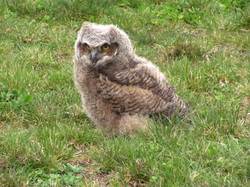

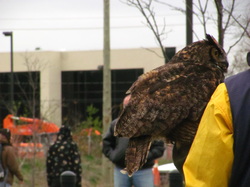
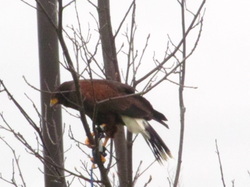
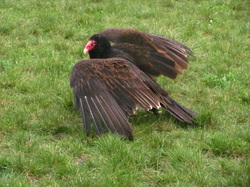

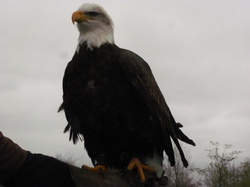
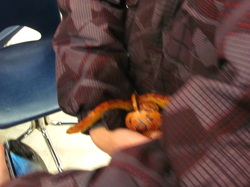
Uncle Travelling Dan
Bird Studies Canada www.bsc-eoc.org
Canadian Raptor Conservancy www.canadianraptorconservancy.com
Canadian Peregrine Foundation www.http://www.peregrine-foundation.ca/
Rare Charitable Wildlife Reserve www.raresites.org
| The Lily Dipper |
|
 Saturday, April 21st was cold and grey. But the Kitchener celebrations of Earth Day out at the Huron Natural Area still managed to attract a few hundred people. The main draw was the aerial demonstration of the Canadian Raptor Conservancy's birds of prey. One of my cousins and his 2 children came out, and we sat right in the front row of bleachers, which was perfect for taking photographs. The bonus was the 'Sssnakes Pavillion', which had a bunch of beautiful (ok, not the snapping turtle, but he was a baby, so he was still cute!) and very friendly snakes and turtles.  We arrived in time for the second of three CRC shows. Apparently, the first show had some unintentional excitement when their adult great horned owl flew off up into some trees, and when our show started, one of the handlers was still trying to coax her back "onto the glove," as falconers say. Instead, the lead birds were two four week old great horned owlets that received a collective 'awwww!' from the crowd. These things are 10 inch tall by 6 inch wide balls of pure grey fluff, with big, googly eyes-and fully developed talons. Extremely cute, both in looks and mannerisms, but already fully armed. The two of them were placed on the grass, and while I was shooting a video of one, he decided to come over and visit me and the stranger beside me, and so he hopped-loped surprisingly quickly over, and was right at my feet before the handler retrieved him. One of the owlets looked up at the sky and started clacking his already-impressive beak, and the falconer said that was possibly the first time he had seen another bird.  These owlets are captive-bred and will remain in captivity all of their lives, mainly to educate people about the avian fauna in their own backyards. If your yard has some mature evergreen trees in it, or nearby, and one morning there is a pile of feathers under your bird feeder, an owl or other raptor may have found dinner! All part of the natural world. If a murder (flock) of crows starts congregating and focuses on a particular tree in the neighbourhood, chances are that they are trying to gang up a big old great horned owl. With good reason, too. These birds are known as the tigers of the forest, because they are fearless -even attacking roosting bald eagles!- and will eat virtually anything within reasonable size. With a crushing power of 500 lbs/square inch in their talons, it is little wonder that the great horned owl has such a ferocious reputation. At the same time, these birds are magnificent animals. A big female will have a wingspan of nearly five feet, and be somewhat larger than the common red-tailed hawk in body, yet it weighs in at only two to two and a half pounds! One more thing, my useless fun fact for the blog: a great horned owl's favourite prey is the skunk! Yep, old Pepe le Peu himself! If a skunk manages to spray the owl, the owl doesn't care, because it does not have a sense of smell.  In all my years of canoeing and journeying through prime owl territory, I have heard them far more often than I have seen them. In fact, I could count on one hand the number I have times that I have actually seen a wild owl of any species, and most of those would be the barred owl, another large owl that rarely ventures south of Georgian Bay. Recently, I was on an owl prowl at Rare, and the guide called in a pair of screech owls, that at full maturity are barely the size of the owlets I mentioned above. That was pretty cool.  The next bird that was shown was a beautiful Harris hawk, a denizen of the American southwest. Black, with brick red and a white band across the tail, this red-tailed size hawk is the only bird of prey to hunt in packs, of up to 10 or 15 birds. Their favourite prey is the jackrabbit, which can weigh up to 10 lbs, as much as 3 or 4 Harris hawks, but, using tactics similar to a wolf pack the rabbit is no match. The hawk in the photo was the first bird to fly in the show, and he promptly decided that the top of the tent, and then a small tree, was a better option than landing on the sign or the falconer's glove! In the wild, these things like to perch on the big saguaro cacti of the Nevada or Arizona desert.  The second-last bird of the show was a turkey vulture. While there are certainly better-looking birds, these things are still very striking, and this one was the class clown among his beak-and-talon showmates. The near 6' wide wingspan is black and white in equal parts, and the body is black, with a naked, pink head, which allows the bird to rip into carrion (dead animals) without the worry of cleaning itself afterwards. Turkey vultures are quite at home on the ground, unlike most raptors. At the Earth Day show, one of the handlers held a piece of chicken in her hand and jogged away from the bird, and he ran after her. His gait was pretty funny, but it worked. Since these birds are scavengers, they have followed the highway system north, well into Ontario, with a buffet of road-kill deer, racoons, and other animals laid out before them. They are often seen soaring in groups, even in the middle of big cities, with wings forming a medium but obvious 'V'. This is called a dihedral. The black and white underwing is usually quite visible. One more fun fact about turkey vultures: to protect the nestlings, the parents will regurgitate food on them to the point where they are so stinky that predators will avoid the nest!  The last bird of the show was, of course, the iconic bald eagle. Rocco, in this case, a young, fully mature male with a 7.5' wide wingspan and about 10lbs in weight. Apparently he was in a rotten mood that day (maybe it was the weather-cold and gray), so he remained 'on the glove.' It is easy to see why this animal is such an icon. Majestic in size, noble in appearance, powerful in flight and battle. On the brink of extinction 30 or 35 years ago, this bird now nests in every state, province, and territory (except for Vermont) with numbers now up to 300 000. However, here in southern Ontario, from approximately Georgian Bay east along Lake Ontario, seeing a bald eagle is still an uncommon sight. There are a few along the Lake Erie coastline (try John E. Pearcey Provincial Park west of St. Thomas), about four or five successful pairs along the Thames River, and in the winter, those of us here in the Kitchener-Cambridge Region can often spot eagles at the confluence of the Grand and Speed Rivers, watching from the shoreline opposite the Rare Conservation Reserve.  My most memorable sighting in southern Ontario was a few years ago, paddling along the Saugeen River. I spotted an osprey and a great egret, and then an absolutely huge eagle. It seemed to be about a full meter in height on it's perch, and the body was jet black, which made the yellow bill and white head and tail stand out even more than normal. It took off, and the wingspan had to be 8' across. It made the osprey look barely as big as red-tailed hawk, and the osprey has a 5' wingspan! That bird was probably a vagrant northern female. The northern eagles are larger, and darker. Rocco's own sister has a wingspan of nearly 9' and a weight of almost 15 lbs. By the way, bald eagles have a crushing power in their talons of 400 psi.  After the great show by the Canadian Raptor Conservancy, my cousin and his kids and I went to the SSSnakes pavillion. The staff have the same purpose as the CRC, to educate the public about Ontario's reptiles and amphibians. The kids, at an age where they can really start to recall what they learn and apply it, were delighted to handle the beautiful and very friendly ball python and fox snake, and the average-looking but still friendly northern water snake. I think the four of us handled these 3 snakes for about 20 minutes in total. In the wild, snakes just want to slither on their merry way and avoid us, and it is important that we allow them to do that, even the endangered Massasauga Rattlesnake. If you see a snake, walk out of it's path, and if you spot a rattler, back away from it and walk around it. The rattlesnake, like every other reptile, just wants to mind it's own business. If you see a rattler, report it to the MNR so they can update their research. Below are some useful links to interesting sites that talk about raptors and the natural world. Spring is here, the trilliums are flowering, and I wish I was trout fishing in Algonquin! (The season opened yesterday, the 28th.) Keep hiking, biking, and so on with your eyes wide open to the wonders of Creation, eh!
Uncle Travelling Dan Bird Studies Canada www.bsc-eoc.org Canadian Raptor Conservancy www.canadianraptorconservancy.com Canadian Peregrine Foundation www.http://www.peregrine-foundation.ca/ Rare Charitable Wildlife Reserve www.raresites.org
0 Comments
|
Categories
All
|